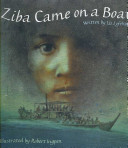
Ziba came on a boat. Sitting in the crowded hull, with her mother’s arms around her, Ziba remembers all that she has left behind. They hope to find peace and safety in a new land, but where will their journey end.
Related: Afghanistan, Asia, Australia, Middle East, Primary (ages 6-9), Realistic Fiction
array(10) {
["isbn"]=>
array(1) {
[0]=>
string(13) "9781933605524"
}
["Author"]=>
array(1) {
[0]=>
string(15) "Lofthouse, Liz."
}
["pubdate"]=>
array(1) {
[0]=>
string(4) "2007"
}
["Illustrator"]=>
array(1) {
[0]=>
string(14) "Ingpen, Robert"
}
["_edit_lock"]=>
array(1) {
[0]=>
string(12) "1593721217:2"
}
["_edit_last"]=>
array(1) {
[0]=>
string(1) "2"
}
["thumb"]=>
array(1) {
[0]=>
string(36) "40a4ccaeadfd21ad29d4656bd7d29234.jpg"
}
["aktt_notify_twitter"]=>
array(1) {
[0]=>
string(2) "no"
}
["_yoast_wpseo_primary_category"]=>
array(1) {
[0]=>
string(2) "60"
}
["_yoast_wpseo_content_score"]=>
array(1) {
[0]=>
string(2) "90"
}
}
- ISBN: 9781933605524
- Author:
Lofthouse, Liz.
- Illustrator:
Ingpen, Robert
- Published: 2007
- Themes: boat, Fear, freedom, Hope, memory, Peace, Refugees, safety, War
- Descriptors: Afghanistan, Asia, Australia, Middle East, Primary (ages 6-9), Realistic Fiction


Your comments reminded me of a book, How Many Days to America by Eve Bunting. The book is dedicated to my class of sixth graders, most of whom were Vietnamese Boat people. They spent their sixth grade year writing the accounts of how they came to America. Their stories inspired Eve. However, the illustrator, Beth Peck, shown the immigrants as Caribbean people. The students were upset. However, as we reflected on that choice we realized that the stories the students told were universal. That may also apply to Ziba.
Seemi
The issues faced by immigrants are grave. Looking at the images of poor immigrants in children’s literature just breaks one’s heart. Ziba is another immigration tale from somewhere purposely left for the audience to decide the setting…(I have a feeling that it is from Afghanistan through reading the visual images of dresses and backdrop by a renowned Australian illustrator). The short picturebook brings together the unrest in some areas of the world and their impact on innocent citizens of the regions. The book, in my opinion, reinforces stereotypes of Muslim immigrants by following the typical themes of representing Muslims: that of poverty, unrest, women’s dress/hijab etc.
The ‘othering’ of the immigrants in comparison as well as the us/other binary position is reinforced in the images of smiling, healthy western kids presented as waiting for the poor, hungry, occupants of the rickety boat. The theme of a Western country as savior is a dominant discourse in the book. This discourse is what I have an issue with as this book comes to us from Australia and the immigrant regulations there are excessively strict to the point that boats carrying immigrants are stopped way before they reach Australian shores rather than being welcomed. But the story provides its audiences with an entirely different perception.
Melissa
I did not “read” Ziba and her sister-travelers as Muslim specifically. In my mind the characters in this story were from the “old country.” I interpreted the head coverings as old-fashioned kerchiefs or headscarves that speak to me of olden days not of Hijab. I think this speaks so much to whom the reader is when she is transacting with texts. I was brought up listening to stories of relatives coming to America through Ellis Island escaping pogroms in Poland and Russia. In the photos I was shone those women wore what headscarves that signified being Orthodox Jews. We really do make sense of story based on our own contexts.
I agree with Seemi’s assessment of this book representing the typical immigrant-victim/receiving country-savior discourse, one that is not only patronizing, but patently false, especially if this story is set in the present and deals with Muslim immigrants. It would be interesting to include this picture book in a text set that shows a variety of immigrant experiences before, during, and after the trip.